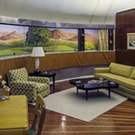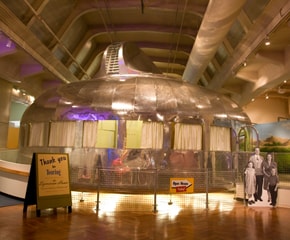What If
While one of Buckminster Fuller’s most ambitious inventions—the Dymaxion House—never achieved commercial success, his unconventional dwelling has inspired generations of innovators Mistakes are great. The more I make, the smarter I get. Buckminster Fuller
Seeing Differently
Long before he was hailed as one of the great American visionaries of the twentieth century, R. Buckminster “Bucky” Fuller (1895–1983) could hardly see. Born cross-eyed and severely nearsighted, his vision was so compromised that he could not make out distinct shapes or colors. Even faces lacked definition, with eyes being especially unreadable (he said they looked like “two dark areas"). He was finally fitted with glasses when he was four years old. “Imagine how exciting it is to see a human eye when you didn’t know it was there!” he once said, adding, “It never occurred to me that what I was seeing wasn’t what everyone else saw.”
Fuller, whose work earned more than two dozen U.S. patents, 47 honorary doctorates, and a 1969 Nobel Peace Prize nomination, is celebrated for seeing what others did not. Most famously he saw lightweight domes and triangular struts where others saw square buildings with peaked roofs and load-bearing walls. His drive to conserve the world’s resources by “doing more with less” led him to create landmark architectural structures, ranging in scale from his two-bedroom Dymaxion House to his United States pavilion at Expo ’67 in Montreal, a spectacular geodesic dome that rose 20 stories above the fairgrounds.

‘World’s Most Successful Failure’
An innovator’s legacy is always debated, but especially so when it’s someone like Fuller, who proudly called himself “the world’s most successful failure.” One of his most famous failed experiments was in 1945, when he attempted to mass-produce low-cost homes on a factory assembly line; his goal was to ship them, pre-assembled, to people in need around the world. Just two prototypes were constructed, and only one full-scale prototype was ever built and lived in. Although Fuller’s Dymaxion House was a commercial failure, his design inquiries contributed to a breakthrough in his thinking about the geodesic dome, which many historians credit Fuller with popularizing in the late 20th century.

Birth of a Nonconformist
Fuller’s ideas about balancing compression and tension in buildings and improving living environments by doing “more with less” were initially inspired by his observations of the natural world. Although he was raised in an intellectual East Coast family, a descendant of Harvard-educated clergymen and lawyers and the nephew of pioneering journalist Margaret Fuller, he departed from a conventional professional career when he was 32, in the throes of a personal crisis following the death of his first daughter and the failure of a construction-related business he’d started with his father-in-law, an architect. As he wrote in his book Critical Path, he “jettisoned all that [he] had ever been taught to believe and proceeded thereafter to reason and act only on the basis of direct personal experience.”
Dymaxion House
Artifact
House
Date Made
1946
Summary
Buckminster Fuller was a multi-disciplinary designer. This house, his re-thinking of human shelter, was rooted in Fuller's understanding of industrial production -- particularly methods developed in the automobile industry and especially those advocated by Henry Ford for whom Fuller had immense admiration. More an engineering solution than a home, the structure was prototyped but never produced.
Place of Creation
Object ID
91.401.1
Credit
From the Collections of The Henry Ford. Gift of the William L. & Marjorie M. Graham Family, Wichita, Kansas
Get more details in Digital Collections at:
Dymaxion House
What is The Henry Ford?
The national attraction for discovering your ingenuity while exploring America’s spirit of innovation. There is always much to see and do at The Henry Ford.
In nature, he saw evidence that self-bracing triangular structures, from spider webs to branching patterns in plants, were inherently more stable than rectangular structures relying on internal supports. His initial sketches for a single-family house show a hexagonal structure with a tent-like roof suspended from a central mast by steel cables. He worked out his ideas by building a small-scale model; it was displayed in a Chicago department store, part of a promotion for a line of modern furniture, which was when an ad man proposed the name “dymaxion” by combining the words “dynamic,” “maximum,” and “tension.” Fuller trademarked the name and used it to brand his house as well as many of his future inventions, including a three-wheeled car, a world map, and an eco-friendly bathroom.
The Rise, Fall, and Return of the Dymaxion House
It took 16 years for technology, in the form of aluminum and high-strength alloys developed for the aviation industry, to catch up with Fuller’s ideas, and allow him to build a full-scale prototype of his Dymaxion House. At the close of the Second World War, workers inside a Wichita-based Beech Aircraft factory stamped out more than 3,000 parts.
Fortune Magazine, April 1946
Artifact
Magazine (Periodical)
Date Made
April 1946
Creators
Place of Creation
Keywords
Object ID
99.158.1
Credit
From the Collections of The Henry Ford.
Location
By Request in the Benson Ford Research Center
Get more details in Digital Collections at:
Fortune Magazine, April 1946
What is The Henry Ford?
The national attraction for discovering your ingenuity while exploring America’s spirit of innovation. There is always much to see and do at The Henry Ford.
Built in days and priced to cost no more than a luxury sedan, Fuller’s house was hailed as an inexpensive solution to the postwar American housing shortage. Disassembled, it weighed 6,000 pounds and its parts could fit into a single steel shipping container. Assembled, it was strong enough to stand up to a Kansas tornado. The press coverage generated more than 30,000 unsolicited orders, and Fortune magazine predicted Fuller’s mass-produced house would have a greater social impact than Henry Ford’s automobile.
But the realities of outfitting a factory for high-volume production runs came with financial costs, upwards of $10 million. When disagreements between Fuller and his investors couldn’t be resolved, the project was shelved, and no houses were produced beyond the prototype. The parts were sold to a local businessman, William Graham, who reassembled them as part of a rural residence for his family. The Graham house was abandoned after William’s death, and in 1991, his family donated it The Henry Ford, where painstaking restoration work took two years.
Fuller believed any experiment undertaken with purposeful, urgent inquiry produced meaningful “artifacts,” as he called them. Artifacts could be big, beautiful objects, but they could also be as ephemeral as ideas about organizing principles of energy, motion, and matter. He especially prized artifacts of ideas and considered them far more useful for changing the world than artifacts of practical or commercial value. “I didn’t set out to design a geodesic dome,” he once said. “I set out to discover the principles operative in Universe. For all I knew, this could have led to a pair of flying slippers.”
With this understanding, the Dymaxion House shimmers with a different kind of brilliance. Yes, it is a model of inventive architectural design, an example of post-war American ingenuity in the way it combines pioneering industrial materials and manufacturing technology to produce an affordable, portable, single-family home. It is also utterly original in appearance, with its carousel-shaped, aluminum-clad exterior and domed roof. And, yes, it displays many fascinating, if somewhat fantastical, amenities, from revolving shelves and a mist-releasing “fog” shower to a toilet designed to shrink-wrap waste for composting.
But it is also an enduring artifact of Fuller’s holistic thinking that led to his celebrated geodesic dome achievements, ideas that have influenced fields beyond architecture, from environmental science to molecular biology. For example, a carbon molecule discovered in 1985 resembled Fuller’s spherical structure; scientists named it a “fullerene” in his honor. As celebrated environmental architect William McDonough says, Fuller “was one of the first thinkers from a design perspective to go from the scale of the molecule to the scale of the galaxy and try to come up with a sort of unified design theory that could transcend dimension. If you stop and think about it, he dealt with how the whole world worked.”
Fuller’s Innovation Legacy
To step inside the Dymaxion House at Henry Ford Museum is to discover the genius of Fuller as he himself liked to learn: by inhabiting spaces, by understanding a design approach of “more with less” through the senses rather than bookish formulas. Walk through the living spaces and you’ll feel the gentle, boat-like sway of its suspended deck. In every room, the curved aluminum roof panels hang high overhead. The middle of the house features a central mast. Anchored in the ground, it supports the weight of the roof and flooring deck. Elements of tension and compression are felt everywhere.
“We didn’t acquire, conserve, restore, and install the Dymaxion House with a view of elevating it into the pantheon of architecture,” says Marc Greuther, Chief Curator at The Henry Ford. “It’s a provocation, a tangible reminder to look at things in a new way. And it still has vibrancy as an intriguing object that’s positioned at the intersection of opportunity and of need. It might’ve been the wrong answer, but the question he was trying to answer is still one that’s getting posed, which is the basic notion of shelter. How do you provide a home for yourself? Fuller moved toward a holistic vision in trying to answer that and turned up information that remains hugely fertile today.”
Browse Collections
Dymaxion House
Artifact
House
Date Made
1946
Summary
Buckminster Fuller was a multi-disciplinary designer. This house, his re-thinking of human shelter, was rooted in Fuller's understanding of industrial production -- particularly methods developed in the automobile industry and especially those advocated by Henry Ford for whom Fuller had immense admiration. More an engineering solution than a home, the structure was prototyped but never produced.
Place of Creation
Object ID
91.401.1
Credit
From the Collections of The Henry Ford. Gift of the William L. & Marjorie M. Graham Family, Wichita, Kansas
Get more details in Digital Collections at:
Dymaxion House
What is The Henry Ford?
The national attraction for discovering your ingenuity while exploring America’s spirit of innovation. There is always much to see and do at The Henry Ford.
Fortune Magazine, April 1946
Artifact
Magazine (Periodical)
Date Made
April 1946
Creators
Place of Creation
Keywords
Object ID
99.158.1
Credit
From the Collections of The Henry Ford.
Location
By Request in the Benson Ford Research Center
Get more details in Digital Collections at:
Fortune Magazine, April 1946
What is The Henry Ford?
The national attraction for discovering your ingenuity while exploring America’s spirit of innovation. There is always much to see and do at The Henry Ford.
Dymaxion House at its 1948-1991 Site, near Andover, Kansas
Artifact
Photographic print
Object ID
P.B.108399
Credit
From the Collections of The Henry Ford.
On Exhibit
Not on exhibit to the public.
Related Objects
Get more details in Digital Collections at:
Dymaxion House at its 1948-1991 Site, near Andover, Kansas
What is The Henry Ford?
The national attraction for discovering your ingenuity while exploring America’s spirit of innovation. There is always much to see and do at The Henry Ford.
Expo 67 United States Pavilion Souvenir Tray, 1967
Artifact
Tray
Date Made
1967
Summary
Expo 67, held in Montreal, Canada, was the most attended world's fair of the 20th century. The United States pavilion, a 250-foot-diameter geodesic dome designed by visionary Buckminster Fuller and architect Shoji Sadao, was an interactive environmental exhibit. It remains the most iconic and fondly remembered of Fuller's built designs. This pavilion survives today as an attraction called the Biosphere.
Object ID
2008.141.1
Credit
From the Collections of The Henry Ford. Gift of J. Marc Greuther.
Location
Not on exhibit to the public.
Get more details in Digital Collections at:
Expo 67 United States Pavilion Souvenir Tray, 1967
What is The Henry Ford?
The national attraction for discovering your ingenuity while exploring America’s spirit of innovation. There is always much to see and do at The Henry Ford.


Buckminster Fuller's Geodesic Dome Being Constructed for the United States Pavilion at Expo 67, 1966-1967
 Details
Details
Buckminster Fuller's Geodesic Dome Being Constructed for the United States Pavilion at Expo 67, 1966-1967
Artifact
Photographic print
Summary
Expo 67, held in Montreal, Canada, was the most attended world's fair of the 20th century. The United States pavilion, a 250-foot-diameter geodesic dome designed by visionary Buckminster Fuller and architect Shoji Sadao, was an interactive environmental exhibit. It remains the most iconic and fondly remembered of Fuller's built designs. This pavilion survives today as an attraction called the Biosphere.
Object ID
2009.120.4
Credit
From the Collections of The Henry Ford.
Location
By Request in the Benson Ford Research Center
Get more details in Digital Collections at:
Buckminster Fuller's Geodesic Dome Being Constructed for the United States Pavilion at Expo 67, 1966-1967
What is The Henry Ford?
The national attraction for discovering your ingenuity while exploring America’s spirit of innovation. There is always much to see and do at The Henry Ford.
Buckminster Fuller Surrounded by Geodesic Structures in His Office, circa 1951
Artifact
Photographic print
Date Made
1967
Keywords
United States, New York, Forest Hills
Object ID
2009.120.1
Credit
From the Collections of The Henry Ford.
Location
Not on exhibit to the public.
Get more details in Digital Collections at:
Buckminster Fuller Surrounded by Geodesic Structures in His Office, circa 1951
What is The Henry Ford?
The national attraction for discovering your ingenuity while exploring America’s spirit of innovation. There is always much to see and do at The Henry Ford.

Discussion Questions
- What or who motivated Buckminster Fuller to innovate?
- What traits of an innovator did Buckminster Fuller illustrate?
- What central problem was Buckminster Fuller trying to solve, and what innovator traits could you apply to solve them?
- Do you think you can be an innovator like Buckminster Fuller? Why or why not?
Fuel Your Enthusiasm
The Henry Ford aims to provide unique educational experiences based on authentic artifacts, stories and lives from America’s tradition of ingenuity, resourcefulness, and innovation. Connect to more great educational resources:























